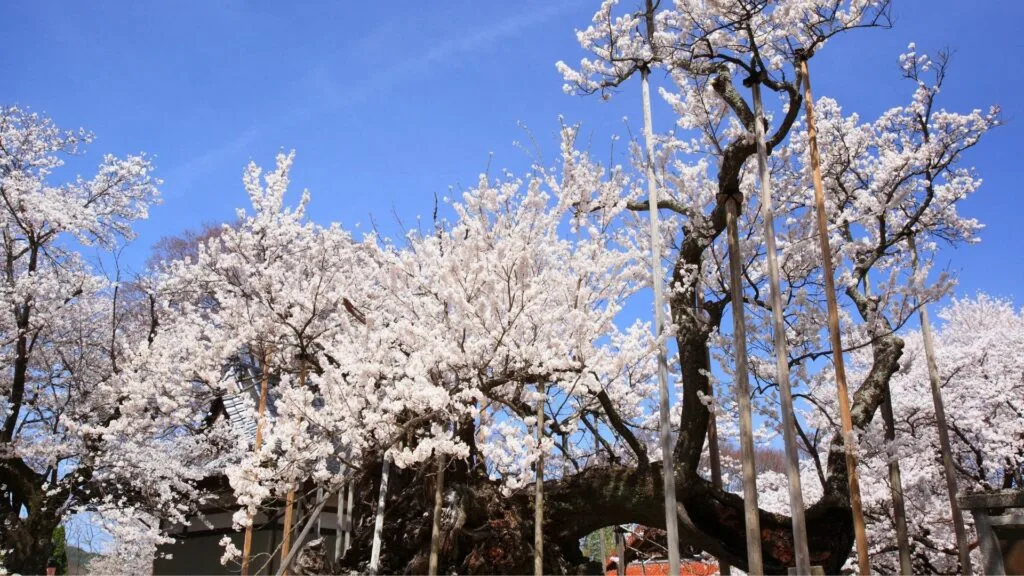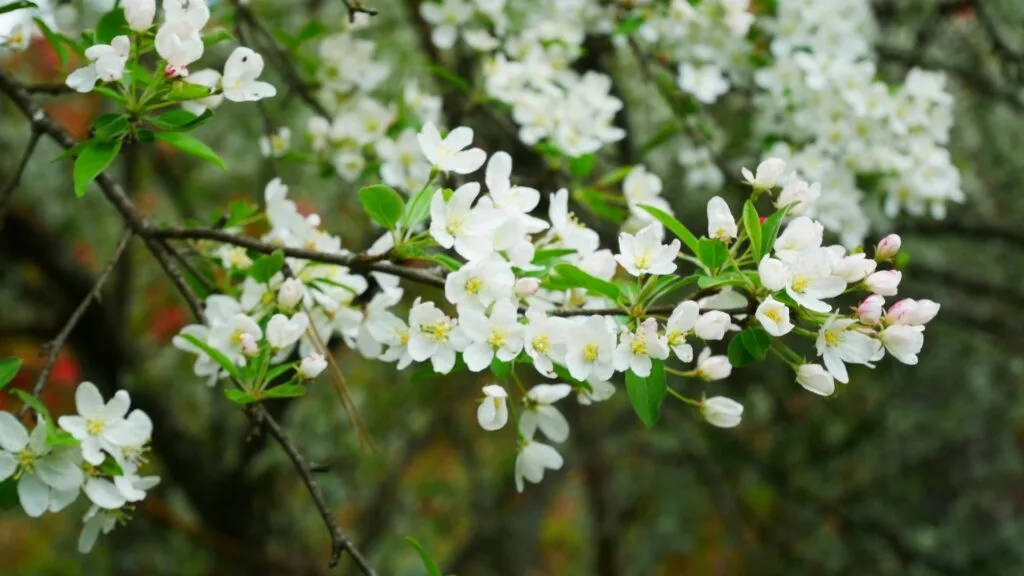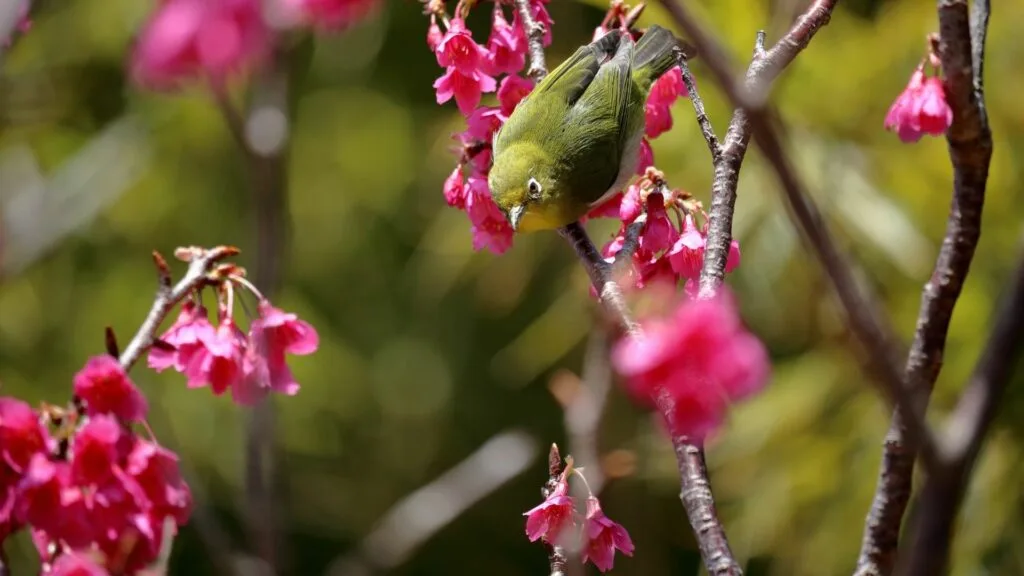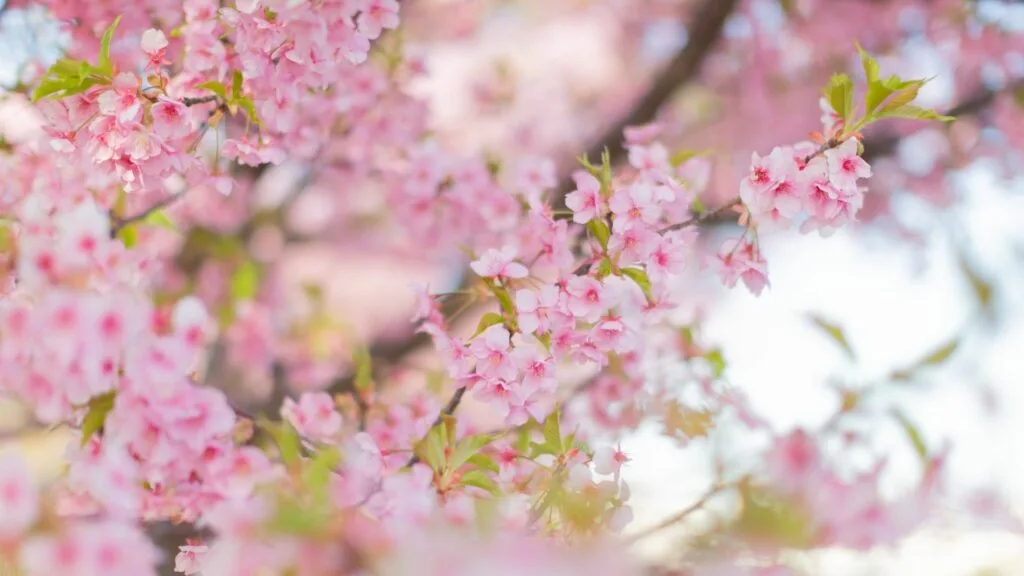Cherry blossoms, or sakura, have been a big part of Japanese culture for centuries. They symbolise beauty, renewal, and how fleeting life can be. While most people know about cherry blossoms, not everyone realises just how many different types exist!
We’ve put together a list of some of the most common and unique types of cherry blossoms in Japan. Each has its own look and charm, so next time you’re out enjoying hanami, take a closer look—you might spot a variety you’ve never seen before!
How Many Types of Cherry Blossoms Are There?

Japan is home to a huge variety of cherry blossoms. There are over 100 wild species and more than 200 cultivated types, all branching from 10 main varieties like Yamazakura, Oyamazakura, and Kasumi-zakura.
Some have five simple petals, while others have multiple layers, creating a fuller, fluffier look. Colours range from pure white to deep pink, and some even change shades as they bloom. Some trees bloom all at once, while others last for weeks. They even have different blooming periods you’ll want to learn about to decide the best month to visit Japan.
Whether you’re walking through a park, visiting a temple, or just enjoying a picnic under the trees, each type of sakura has something special to offer.
Common Types of Cherry Blossoms in Japan 🌸
From massive trees lining city streets to delicate varieties tucked away in gardens, here are some of Japan’s most well-known cherry blossoms.
1. Yoshino Cherry Tree

📅 Best time to see it: March–April
The Yoshino cherry is the most well-known and widely planted cherry blossom in Japan. If you’ve ever seen pictures of streets lined with pink-and-white sakura tunnels or parks covered in a blanket of cherry blossoms, chances are, those were Yoshino cherry trees. This variety was first developed during the Edo period in Somei Village and is a hybrid of the Oshima cherry and Edohigan.
One of the most unique things about Yoshino cherries is that they are clones. Since they are propagated through grafting rather than seeds, every Yoshino tree of the same lineage blooms at exactly the same time. This creates the breathtaking, synchronized full bloom that makes cherry blossom season in Japan so spectacular.
At first, Yoshino cherry blossoms appear as soft pink buds, but as they fully open, they turn pure white before eventually falling. The petals drop in such a way that they look like pink snowflakes floating through the air, a sight that is celebrated in both poetry and modern photography.
These trees are planted all over Japan, from parks and castle grounds to riverbanks and schoolyards. They are also the main species used in tracking the cherry blossom front, the wave of blooming trees that moves northward across the country in spring. If you visit Japan during peak hanami season, the Yoshino cherry will be the star of the show.
2. Edo Higan Cherry Tree

📅 Best time to see it: Late March (blooms about 10 days earlier than other types)
The Edohigan cherry tree is one of the oldest and longest-living sakura varieties in Japan. Unlike Yoshino cherry trees, which are often planted in parks and cities, Edohigan trees are mostly found in mountainous regions. They are incredibly resilient, with some of Japan’s most famous sakura trees belonging to this species.
The blossoms of the Edohigan are small, delicate, and light pink, fading to almost white as they reach full bloom. While they may not be as showy as the Yoshino cherry, they make up for it with their impressive lifespan—many Edohigan trees live for hundreds or even thousands of years.
Some of Japan’s oldest and most legendary sakura trees belong to this species. The Miharu Takizakura in Fukushima, one of the “Three Great Cherry Trees of Japan,” is an Edohigan tree that is estimated to be over 1,000 years old. Even more impressive is the Jindai Zakura in Yamanashi Prefecture, believed to be over 2,000 years old. These trees are national treasures, drawing thousands of visitors every spring.
Another interesting fact about Edohigan is that it was used in creating the Yoshino cherry. Without this ancient variety, Japan’s most famous sakura wouldn’t exist.
3. Mamezakura

📅 Best time to see it: Late March–Early April (Tokyo)
The Mamezakura, also known as the Fuji cherry, is one of Japan’s smallest cherry tree species, both in size and flower shape. This variety is native to the Mt. Fuji region, where it thrives in the rocky and mountainous terrain.
Unlike the towering Yoshino cherry, Mamezakura trees are much smaller, often growing to only a few meters in height. The flowers themselves are also tiny, measuring just 1–2 cm in diameter. They range in colour from pure white to soft pink and have a slight downward-facing shape, making them look more delicate compared to other cherry blossoms.
Despite its small size, the Mamezakura is incredibly tough. It can grow in poor soil conditions where other cherry trees wouldn’t survive, and it has a longer lifespan than many cultivated varieties. This resilience has made it an important species for breeding, contributing to the development of other hybrid sakura varieties.
Because it is naturally found around Mt. Fuji and the Fuji Five Lakes area, Mamezakura trees often add to the already stunning scenery of this famous region. If you’re visiting in spring, keep an eye out for these little blossoms nestled among the landscape!
4. Yamazakura Wild Cherry Tree

📅 Best time to see it: Mid-March–Late April (varies by location)
The Yamazakura is Japan’s most widespread wild cherry tree, found naturally in mountainous forests across the country. Unlike cultivated cherry trees, which are often planted for hanami, the Yamazakura grows naturally and has been part of Japan’s landscape for centuries.
One of the biggest differences between Yamazakura and other cherry blossoms is that its leaves appear at the same time as its flowers. While most sakura bloom first and sprout leaves later, the Yamazakura’s reddish-brown leaves grow alongside the pale pink or white blossoms. This creates a unique contrast between the flowers and foliage, giving the tree a more natural, earthy look.
Historically, Yamazakura trees have been deeply connected to Japanese poetry, art, and folklore. They were the original “cherry blossoms” mentioned in ancient texts before cultivated varieties like the Yoshino cherry became popular. Even today, they are admired for their wild, untamed beauty.
Because Yamazakura trees grow in the wild, they are best seen in mountainous areas rather than city parks. If you’re hiking through regions like Kyoto, Nara, or Kagoshima in spring, you’ll likely see these blossoms blending seamlessly into the forest scenery.
5. Oyama Cherry Tree

📅 Best time to see it: Mid-April–Early May (Hokkaido, Nikko)
The Oyamazakura, also known as the Ezo Yamazakura, is a large, hardy sakura variety that thrives in cold climates, particularly in Hokkaido and northern Japan. It is a close relative of the Yamazakura but has larger flowers and leaves, making it stand out even more.
The blossoms of the Oyamazakura are deep pink and noticeably bigger than those of the Yoshino cherry. The petals have a slightly thicker texture, allowing them to withstand harsher weather conditions. The tree itself can grow up to 20 meters tall, towering over many other sakura species.
One unique feature of the Oyamazakura is that it produces small, dark purple cherries in summer, which attract a variety of birds. While these cherries are not typically eaten by humans, they play an important role in the local ecosystem.
If you’re in Hokkaido during cherry blossom season, the Oyamazakura is one of the most striking trees you’ll see. It blooms later than many other varieties, so if you missed the sakura season in places like Tokyo or Kyoto, heading north to see these stunning blossoms is a great option.
6. Kanhi-zakura

📅 Best time to see it: Late January–February (Okinawa), Mid-March (Tokyo)
The Kanhi-zakura, also known as the Taiwan cherry, is one of the earliest blooming cherry blossoms in Japan. While most sakura varieties start to bloom in March or April, Kanhi-zakura trees begin to flower as early as January in Okinawa, bringing a splash of colour to the winter landscape.
Unlike the soft, pastel hues of Yoshino cherry blossoms, Kanhi-zakura flowers are a deep, vibrant magenta, giving them a striking, almost tropical look. The petals are thicker and waxier than those of other sakura varieties, which helps them resist cold and wet conditions. Another unique characteristic of Kanhi-zakura is the way its flowers bloom—instead of the petals falling off one by one, the entire flower drops off at once, creating a different kind of “sakura snow.”
This variety thrives in warmer regions, which is why it is most commonly found in Okinawa, Kyushu, and southern parts of Honshu. In Okinawa, it’s sometimes called “Hikanzakura” or “New Year’s Sakura” because it starts blooming just after the new year. The cherry blossom festivals in Okinawa, such as the Nago Cherry Blossom Festival and the Yaedake Cherry Blossom Festival, are among the first hanami events of the year in Japan, attracting visitors eager to see the season’s first sakura.
Kanhi-zakura is also one of the parent species of the famous Kawazu-zakura, which inherits its bright pink colour and early blooming nature. If you want to see cherry blossoms before spring even arrives, Kanhi-zakura is the one to look for!
7. Oshima Cherry Blossom (Oshima Sakura)

📅 Best time to see it: Early–Mid-March (Izu Peninsula)
The Oshima-zakura is one of the most unique cherry blossom varieties in Japan, known for its pure white flowers and sweet fragrance. Unlike many cherry blossoms, which have little to no scent, Oshima-zakura blossoms emit a strong, fruity aroma, making them a standout among sakura species.
Native to the Izu Peninsula and the Seven Islands of Izu, this variety has played a major role in Japan’s cherry blossom history. It is actually one of the parent species of the famous Yoshino cherry, meaning without the Oshima-zakura, Japan’s most iconic sakura variety wouldn’t exist.
The flowers of Oshima-zakura are larger than those of the Yoshino cherry, with pure white petals that sometimes have a greenish tint. Another unique feature is that its leaves appear at the same time as the blossoms, rather than after the flowers have fallen. These leaves are not just for show—they are actually used in Japanese sweets, particularly in sakura mochi, where they are salted and wrapped around the rice cake to add flavour.
Oshima-zakura trees also grow faster and stronger than many other cherry blossom varieties, making them a popular choice for breeding new hybrid sakura. If you ever come across an Oshima cherry tree, take a moment to appreciate both its beautiful white petals and its rare, natural fragrance—it’s one of the few cherry blossoms you can enjoy with more than just your eyes!
8. Kawazu Zakura

When to see Kawazuzakura: Early to mid-March (Izu Peninsula).
The Kawazuzakura, renowned for its vibrant pink or pale crimson flowers, boasts a diameter of approximately three centimeters. Clustering in groups of four to five blossoms, these flowers create a captivating spectacle against the backdrop of shiny, purple-brown bark. Originating as a natural hybrid of Prunus campanulata and Prunus speciosa, the Kawazuzakura earned its name from its transplantation to Kawazu Town. This charming town has become a hotspot for tourists, drawn by the allure of the Kawazuzakura’s early blooming season. Unlike other cherry blossoms, the flowering period of the Kawazuzakura extends for a month, offering an extended opportunity for visitors to revel in its beauty.
Don’t Miss These Stunning Sakura on Your Trip to Japan
And there you have it—eight incredible cherry blossom trees that you definitely shouldn’t miss when visiting Japan!
For centuries, cherry blossoms have held a special place in Japanese culture. Their blooming season has long been seen as a sign of good fortune for the year ahead. Hanami, the tradition of gathering under the blossoms to appreciate their beauty, started as a ritual to pray for a good harvest and has since become a beloved way for people to welcome spring. Today, it’s a celebration enjoyed by locals and visitors alike.
If you’re lucky enough to be in Japan during cherry blossom season, make sure to visit some of the best viewing spots. Whether you’re taking a peaceful walk through a garden, enjoying a picnic under the petals, or simply admiring the view, the sight of cherry blossoms in full bloom is something you’ll never forget. Just be sure to follow local customs—respect the trees, clean up after yourself, and soak in the magic of the moment.
No trip to Japan in spring is complete without experiencing the beauty of sakura. So as you plan your visit, make time to witness this breathtaking seasonal spectacle—it’s a tradition that truly captures the spirit of Japan in bloom. 🌸








